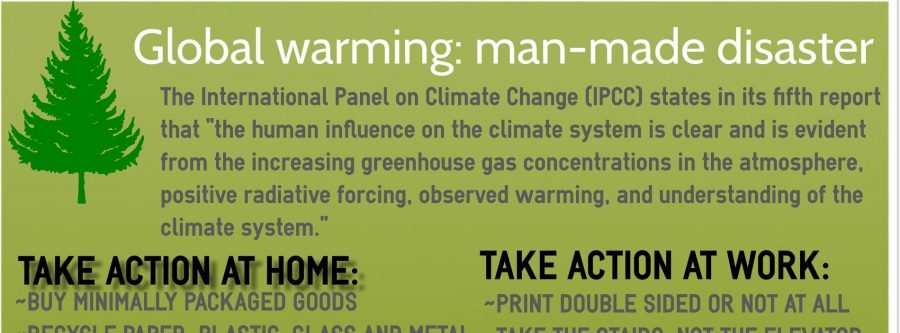Without change, global warming plan fails to heat up
December 10, 2014
As an estimated 250 million cars rumble across the vast United States highway system, an invisible, dangerous threat to American safety looms in the air: carbon emissions. More of a threat to humanity than Ebola or any other disease, carbon emissions threaten all life on Earth. There is a government plan to combat these emissions, but it is merely a step in the right direction, not doing enough to protect the lives of people everywhere.
There are an estimated 5 billion metric tons of carbon dioxide emissions released in the United States alone every year, and that number is only expected to grow. While some emissions are needed for the Earth’s processes, the emissions that are not used up (and are caused almost entirely by human interference) will not go away for at least 1000 years, according to the Environmental Protection Agency.
The current plan for cutting back on carbon emissions, set in late September by President Obama at a United Nations meeting with China and several other world powers, is to cut carbon emissions from freight and transportation in the United States by 26 to 28 percent of the 2005 level, finishing in 2025. Meanwhile, as the plan slowly takes effect, emissions will still be released into the air, causing major problems for life on Earth. If the United States does not carry out the plan sooner, as well as eliminate more emissions than planned, the little amount of precious ozone the Earth contains will soon be wiped out, causing mass destruction and possibly the end of all life on Earth.
While the threat seems to loom over humanity’s head, many leading researchers actually believe it lies underground, in the massive amounts of coal dug up every year in the United States. In 2012 alone, 1.02 billion tons of coal were mined in the United States, according to the Energy Information Administration.
The effects of carbon emissions and global warming are not just a far-away threat. According to the Union of Concerned Scientists, a group of scientists and engineers devoted to solving the problem of global warming, many problems have already been created, from an elongated wildfire season to a drastic sea level increase. Since 1880, the global sea level has risen eight inches, but it is even larger on the east coast and the Gulf of Mexico, rising as much as 12.5 inches. Wildfires are also more common than ever before, due to the higher spring and summer temperatures caused by global warming. Because of these wildfires, tens of millions of trees have died in the Rocky Mountains over the past 15 years, which only generates more problems.
There are, of course, ways to avoid global warming altogether, but just cutting carbon emissions, as the current plan dictates, is not one of them. Economically, alternatives to fossil fuels tend to cost more, and usually are not as effective. One such example is solar power, which not only costs up to up to $100 more for the same amount of energy, but also requires the weather to cooperate to be at all effective. Other energy sources in consideration are wind, water and electricity, yet all of them have major drawbacks. These methods, while costly, will end up saving all people more money and maybe even their life in the long run.
Global warming is a pressing problem, so the plan that was set in late September is a good start. But, if the United States and its citizens want true protection from the disastrous effects of global warming, the current plan does not even come close to achieving that goal.








